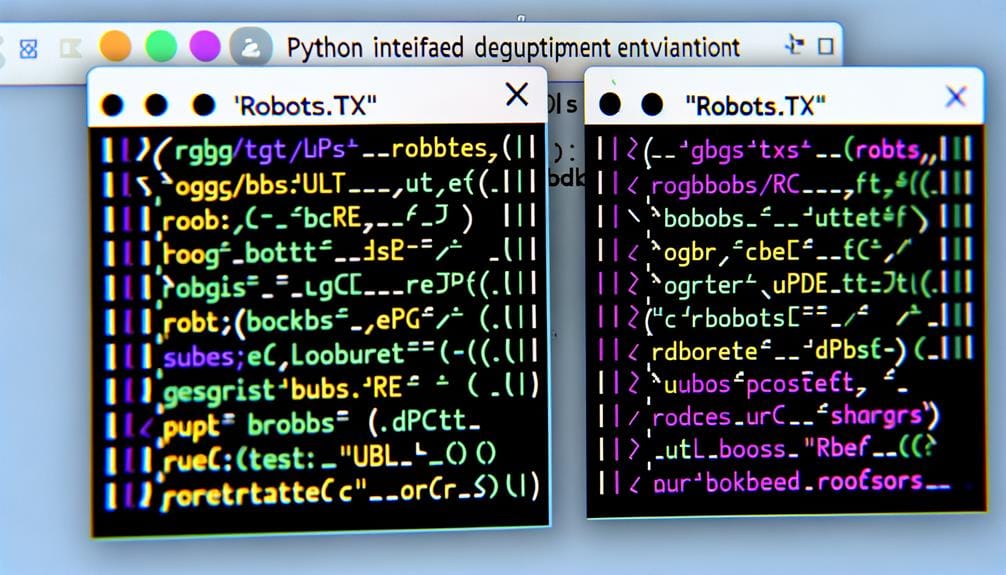To check and analyse robots.txt files using Python, we'll use functions like 'robotstxt_to_df' to convert files to DataFrames for detailed examination. We access and scrutinize the directives and the content, identify disallowed and allowed URLs, and inspect user-agents' role in SEO control. Using urllib.robotparser implementation maintains web crawling policies, and the robotstxt_test() function tests URLs against your robots.txt file. Comparison of various robots.txt files leads to more strategic SEO decisions based on factors like URL blocking policies. Dive deeper to leverage regular sitemap analysis and Python automation for persistent, effective SEO optimization.
Key Takeaways
- Utilize Python's `urllib.robotparser` to fetch and interpret robots.txt files for analysis.
- Use the `robotstxt_to_df()` function to convert the robots.txt file into a DataFrame, isolating critical columns like 'Directive', 'Content', and 'Download_date'.
- Apply the `robotstxt_test()` function to examine specific URLs against the rules within the robots.txt file, identifying disallowed and allowed URLs.
- Implement the `robotstxt_analysis()` function to summarize the robots.txt file, guiding strategic SEO decision-making.
- Compare different robots.txt files by analyzing the DataFrame outputs and consider the impact of user-agents and URL blocking policies on SEO optimization.
Understanding Robots.txt File Analysis
To kickstart our understanding of robots.txt file analysis, we need to dive into the functionality of Python functions such as robotstxt_to_df), which allows us to convert these critical files into data frames for a more granular and efficient analysis. It's a key step in our journey toward robots.txt data visualization. This function enables us to isolate and examine columns like 'Directive', 'Content', 'Robotstxt_url', and 'Download_date'. We're particularly interested in identifying disallowed and allowed URLs, as these are significant for SEO optimization. Also, we can't overlook the power of Python script automation in this process. By scripting these tasks, we're ensuring a consistent, repeatable analysis, saving us time and reducing the risk of errors. This automated approach simplifies not only our workflow but also our understanding of the complex world of robots.txt files.
Python Functions for Robots.txt Analysis

Delving into Python's toolbox, we find a host of functions uniquely tailored for analyzing robots.txt files, bolstering our SEO strategies with data-driven insights.
- Python automation is key in this process, as it allows us to run scripts that automatically fetch and dissect these files. Libraries like `urllib.robotparser` are instrumental in implementing web crawling policies based on the robots.txt content.
- The function `robotstxt_test()` can be used to test URLs against the robots.txt file, securing our web crawling efforts.
- In terms of data visualization, the `robotstxt_to_df()` function is invaluable, converting the file into a DataFrame, facilitating the interpretation of SEO metrics.
- Lastly, the `robotstxt_analysis()` function provides a summary of the robots.txt file, aiding in strategic SEO decision making. Python's prowess in handling robots.txt files is clear, offering efficient, data-driven solutions for SEO challenges.
Importance of Sitemap Analysis

In the realm of SEO optimization, analyzing sitemaps holds prime importance, as it provides a structured view of a website's content, facilitating better indexing by search engines. This structured view aids the indexing strategy, allowing search engines to classify and rank content effectively. Furthermore, sitemaps enhance crawl efficiency by guiding search engine bots to relevant and updated content, saving valuable crawl budget. By parsing sitemaps, we can gain insights into the hierarchy and chronology of content, helping us to plan and execute our SEO strategies more accurately. To sum up, sitemap analysis is crucial for any website seeking to improve its visibility on search engines, and when combined with other techniques like robots.txt analysis, it can significantly boost our SEO performance.
SEO Optimization Through Sitemap Analysis

Harnessing the power of Python, we can significantly streamline the process of sitemap analysis for superior SEO optimization. We use Python's capabilities to:
- Simplify content categorization: Python libraries allow us to analyze sitemaps, better categorizing content for improved search visibility.
- Enhance indexing strategies: By meticulously analyzing sitemaps, we can strategize our content indexing for superior SEO performance.
- Automate sitemap analysis: We can automate the extraction and analysis of sitemap addresses, enhancing crawl efficiency.
- Regularly update sitemaps: Python scripts enable us to regularly check and update sitemap addresses, a critical aspect of SEO success.
This detailed, analytical, and technical approach optimizes SEO by providing a clearer picture of how content is organized and indexed.
Role of User-agents in SEO Control

As we explore the technicalities of SEO optimization further, we find that user-agents in robots.txt files play a pivotal role in shaping our web crawling behavior. User-agents dictate which web crawlers can access what part of your website. They are keys to implementing effective web crawling strategies. Our user agent analysis reveals that they can be specific, targeting a single bot, or generic, addressing all bots. Misuse or misinterpretation of user-agent directives can lead to unintended SEO consequences. By using Python, we can assess and streamline these directives, ensuring that our desired web crawlers are not blocked from important pages. This, in turn, optimizes our SEO efforts by controlling crawler access and improving our site's visibility.
URL Blocking Policies for SEO

While we've learned to appreciate the role of user-agents in SEO control, we must now turn our attention to URL blocking policies and their impact on SEO strategies. Properly implemented, these policies can have significant SEO implications.
- Disallowed URLs: URL blocking policies can restrict search engine bots from crawling and indexing certain parts of your website, preserving your crawl budget.
- Control Over Indexing: Carefully crafted policies can guide search engines to high-value pages, boosting SEO efforts.
- Crawling Restrictions: Overly restrictive policies can result in important pages being overlooked, negatively impacting SEO.
- SEO implications: Incorrectly implemented URL blocking can lead to SEO issues like duplicate content, affecting your site's search engine ranking.
Comparing URL Blocking Strategies

Diving into the comparison of URL blocking strategies, we can use Python to analyze and contrast how different websites, such as the New York Times and the Washington Post, implement their URL blocking policies for SEO optimization. We're essentially comparing crawler access across diverse domains. By evaluating disallowed URLs, we can discern distinct SEO strategies, shedding light on the nuances of content accessibility for web crawlers. Python's powerful libraries aid us in extracting and interpreting data from robots.txt files, making this comparison feasible. By doing so, we can identify potential improvements in URL blocking strategies, ultimately enhancing SEO performance. Remember, a well-structured robots.txt file is crucial for successful SEO. It's all about striking the right balance between accessibility and restriction.
Future Guidelines for Robots.txt Analysis

Having explored the comparison of URL blocking strategies, we now turn our attention towards the future guidelines for robots.txt analysis.
- Embrace Future Trends: We'll focus on emerging concepts and technologies in SEO. This includes advancements in AI, machine learning, and their application in robots.txt analysis.
- Advanced Techniques: We'll delve deeper into Python libraries, exploring how we can leverage them for more complex analyses.
- Automated Monitoring: Setting up automated systems for ongoing monitoring of robots.txt files will become paramount.
- Community Contributions: We'll open the floor for SEO professionals to share their insights and techniques.
In essence, the future of robots.txt analysis involves continuously adapting to future trends, employing advanced techniques, and fostering a community of shared knowledge.
Frequently Asked Questions
What Is the Role of Python Libraries in Analysing Robots.Txt Files?
We use Python libraries like Advertools for efficient analysis of robots.txt files. They convert complex files into clear data frames, making our job easier – a true case of 'work smarter, not harder'. However, library limitations exist, like handling large files. Nevertheless, Python's efficiency outweighs these hurdles, providing us with detailed insights into crawling policies and user-agents, vital for successful SEO strategies.
How Does Sitemap Analysis Contribute to Content Strategy Enhancement?
We're big believers in sitemap analysis for content strategy enhancement. By utilizing sitemap creation tools, we can better organize and categorize our content for improved indexing. This aids in structured data optimization, ensuring our content is easily searchable and accessible. Regularly analyzing and updating our sitemaps allows us to stay ahead in our SEO strategies, ensuring our content reaches the right audience at the right time.
Can User-Agents Improve Website Visibility on Search Engines?
Yes, we can improve website visibility on search engines through user-agent customization. By tailoring robots.txt files, we're able to guide search engine algorithms, ensuring they crawl and index our site effectively. It's like giving them a roadmap of our site, highlighting what's important and what's not. This strategic control of crawling behavior enhances our search engine visibility, aiding our overall SEO strategy.
Do URL Blocking Policies Impact a Websites SEO Performance?
Indeed, URL blocking policies significantly impact a website's SEO performance. Policy implications might include reduced visibility of blocked content. We can use Python to analyze these policies, identifying which URLs are disallowed in the robots.txt file. This analysis helps us understand the reasons behind certain SEO challenges, and accordingly, we can refine our strategies. It's crucial to regularly review and update these policies to ensure optimal website visibility.
What Are the Future Trends in Robots.Txt File Analysis for Seo?
We're seeing a shift in robots.txt file analysis for SEO, with AI integration becoming a game changer. AI's ability to understand and adapt to evolving SEO algorithms allows for more nuanced analysis. This trend is set to revolutionize how we optimize websites for search engines, making SEO efforts more efficient and effective. As algorithms become smarter, our approach to analyzing and implementing robots.txt files must also evolve.



